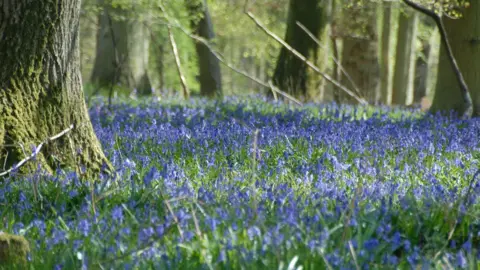Project reveals undiscovered ancient woodlands
 Steve Hubbard/BBC
Steve Hubbard/BBCA two-year project across three counties has uncovered more than 1,300 hectares (3,271 acres) of previously unknown ancient woodland.
These are woods that have persisted since 1600, packed with a range of forest-loving plant life, fungi, insects and micro-organisations, making up some 2.5% of UK land (609,990 hectares or 1,507,318 acres).
The project was run by the Wildlife Trust for Bedfordshire, Cambridgeshire and Northamptonshire. The total area of ancient woodland in the area is now known to be 12,552 hectares (31,016 acres).
Habitat survey officer Katharine Flach said what most surprised her was to discover "ancient woodland can be all around us, across all the three counties".
"There are lots of small pockets nearer to urbanisation that weren't known about or weren't part of the inventory and often are publicly accessible," she said.
 Alex Dunlop/BBC
Alex Dunlop/BBCMs Flach began her research by looking at the Ancient Woodland Inventory, which was compiled in the 1980s and 1990s as part of a national update.
She then delved into centuries-old maps held by Cambridge University and the Cambridgeshire Archives and deployed LiDAR (Light Detection and Ranging) to map the range of existing woodland.
The potential new ancient woodland sites were assessed on the ground.
Ms Flach said: "There are a variety of things to look for, some of the large trees are old, but it's not only that, it's more important to look at the ground flora... the great diversity of species that exists only in ancient woodland.
"They've had hundreds of years of growth and decay, that has allowed those species to build up and also they've been here for so long.
"While planting new woodland can attract these species, they are very slow to spread... it's hard for them get get from isolated ancient woodlands to newer and even fairly old woodland."
Indicator plants include bluebell, wood anemone, woodruff and ransoms.

Once a piece of woodland is designated ancient it will receive some protection from development.
Ms Flach said she was optimistic about the future of the rare habitats.
"It used to be they earned their way by being useful valuable resource, which we don't see them as any more, but I think people realise now the importance of trees of nature and are beginning to look to ways to improve," she said.
"Knowing where those really valuable biodiverse areas are means you can try and join up these landscapes and draw up buffers around these really important sites."
 Alex Dunlop/BBC
Alex Dunlop/BBCFollow Cambridgeshire news on BBC Sounds, Facebook, Instagram and X.
